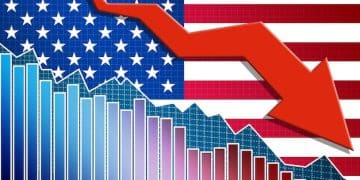New Corporate Tax Rate 2025: Impact on US Business Investments?

The potential impact of a new corporate tax rate in 2025 on US business investments is a critical subject for corporations and the broader economy, with debates focusing on how such changes might influence capital allocation, job creation, and global competitiveness.
As 2025 approaches, an essential question for the American economic landscape is: Is the New Corporate Tax Rate Impacting US Business Investments in 2025? This query resonates through boardrooms, policy discussions, and investment committees across the nation. The answer carries significant implications, potentially reshaping corporate strategies, influencing job growth, and altering the global competitive standing of US businesses.
Understanding the Proposed Corporate Tax Changes for 2025
The discussion around a new corporate tax rate in 2025 is not merely theoretical; it stems from broader economic policy debates and the potential for legislative shifts. Historically, corporate tax rates in the US have fluctuated, reflecting differing economic philosophies and revenue needs. Recent years have seen significant reforms, and the prospect of further adjustments keeps businesses on edge, constantly evaluating their long-term financial health and operational strategies.
Policymakers often weigh diverse objectives when considering tax reforms. On one hand, higher corporate taxes could generate more government revenue, potentially funding public services or reducing national debt. On the other, proponents of lower taxes argue that such reductions stimulate economic growth by freeing up capital for investment, innovation, and job creation. The delicate balance between these competing priorities is at the heart of the current debate, making any proposed changes highly scrutinized.
Historical Context of US Corporate Taxation
To fully grasp the potential implications of new tax rates, it is crucial to look back at the historical trajectory of US corporate taxation. From the high rates of the mid-20th century to more recent reductions, each era has left its mark on business behavior and economic outcomes. The Tax Cuts and Jobs Act (TCJA) of 2017, for instance, significantly lowered the corporate tax rate from 35% to 21%, a move intended to boost domestic investment and repatriate offshore profits. Its effects are still being analyzed, forming a baseline for future policy decisions.
- Pre-TCJA Era: High statutory rates but often mitigated by deductions and credits, leading to lower effective rates for many corporations.
- TCJA 2017 Reform: A dramatic reduction to a flat 21%, aiming to enhance US competitiveness and encourage domestic capital allocation.
- Post-TCJA Analysis: Ongoing debate about the true impact of the 2017 reforms on investment, wages, and economic growth, informing future policy.
Understanding this history allows us to anticipate the likely arguments and potential ripple effects of any new tax legislation. Every change, whether an increase or decrease, becomes a variable in the complex equation of corporate financial planning and strategic direction.
Sources and Drivers of Potential New Rates
The push for new corporate tax rates in 2025 can originate from various sources. A change in political leadership often brings a new fiscal agenda, prioritizing different economic outcomes. Global tax harmonization efforts, such as those led by the OECD to establish a global minimum corporate tax, also play a role. These international initiatives aim to reduce tax competition among nations and prevent profit shifting, which could compel the US to adjust its domestic rates to remain aligned with global standards or risk disproportionately impacting its multinational corporations.
Another significant driver is the need for government revenue. Elevated national debt, unexpected economic downturns, or ambitious spending proposals on infrastructure, climate change, or social programs could necessitate an increase in corporate tax contributions. These macroeconomic pressures can swiftly alter the political appetite for tax adjustments, sometimes overriding previously established economic philosophies.
Finally, public sentiment surrounding corporate responsibility and wealth distribution can influence policy decisions. Periods of heightened income inequality or perceived corporate tax avoidance often lead to calls for corporations to pay a “fair share,” providing political momentum for tax hikes. This interplay of political will, economic necessity, and public opinion shapes the path forward for corporate tax policy.
Direct Impacts on Corporate Investment Decisions
The prospect of a revised corporate tax rate for 2025 directly influences how businesses evaluate new projects, expand operations, and allocate capital. A higher tax rate, for example, can reduce the after-tax return on investment (ROI) for a given project, making it less attractive. Conversely, a lower rate increases the net profit, incentivizing more aggressive expansion and risk-taking. Companies primarily focus on maintaining and growing shareholder value, and tax rates are a significant determinant of this value.
Investment decisions are multifaceted, involving assessments of market demand, operational costs, regulatory environments, and labor availability. However, the corporate tax rate acts as a critical overlay, determining the ultimate profitability of any venture. US businesses, especially those with significant capital expenditure plans, meticulously model these tax implications into their long-term financial forecasts, often leading to adjustments in their investment timelines or project scopes based on anticipated policy changes.
Capital Allocation and Reinvestment Strategies
When the corporate tax rate changes, companies often re-evaluate their capital allocation strategies. A higher tax burden might lead businesses to prioritize less capital-intensive projects or to divert funds towards activities that offer greater tax advantages, such as investments in research and development (R&D) if specific tax credits are available. For example, if the after-tax cost of a new factory increases due to a higher tax rate, a company might delay construction or choose to upgrade existing facilities rather than building new ones.
Conversely, a lower tax rate provides companies with more retained earnings. This increased liquidity can be channeled into various avenues:
- Domestic Expansion: Investing in new plants, equipment, or technologies within the US.
- Shareholder Returns: Distributing profits through dividends or share buybacks, which can boost stock prices but may not directly create jobs.
- Debt Reduction: Strengthening the balance sheet by paying down existing debt.
- International Ventures: Expanding operations into foreign markets, though this depends on global tax considerations.
The interplay of these decisions shapes the overall investment climate and determines where capital flows, affecting economic growth and employment within the US and potentially abroad.

Impact on Mergers and Acquisitions (M&A)
Corporate tax rates also play a pivotal role in the M&A landscape. Changes in these rates can significantly alter the valuation of target companies and the attractiveness of acquisition deals. A higher corporate tax rate, for instance, might make a company’s future earnings less valuable, potentially depressing acquisition prices or reducing the incentive for strategic mergers. Buyers might demand a higher discount rate to compensate for increased tax liabilities, especially for companies with substantial future earnings potential.
Moreover, tax policy can influence the structure of M&A deals. Certain tax incentives, such as those related to asset depreciation or the treatment of goodwill, can become more or less appealing under new tax regimes. Companies might explore alternative acquisition structures or financing methods to optimize their tax position post-merger. The uncertainty surrounding future tax rates can also cause companies to accelerate or delay M&A activities, trying to complete deals under a more favorable tax environment or waiting for clarity on upcoming changes.
US Competitiveness in a Global Economy
The question of Is the New Corporate Tax Rate Impacting US Business Investments in 2025? extends beyond domestic borders, directly influencing America’s standing in the fiercely competitive global economy. Corporate tax rates are a significant factor for multinational corporations deciding where to establish operations, conduct R&D, and locate intellectual property. A higher US corporate tax rate could make other countries with lower rates more attractive for foreign direct investment (FDI), potentially diverting capital and jobs away from the US.
This dynamic creates a constant tension for policymakers: balance the need for domestic revenue with the imperative to maintain competitive appeal. If the US corporate rate becomes an outlier compared to its economic peers, it risks “tax inversion” scenarios, where US companies relocate their legal domicile to lower-tax jurisdictions, or a reduction in global companies choosing the US as a hub for expansion. This erosion of the tax base can paradoxically lead to less revenue in the long run.
Attracting and Retaining Foreign Direct Investment (FDI)
Foreign Direct Investment (FDI) is a vital component of economic growth, bringing capital, technology, and job creation to the host country. The corporate tax rate is a key determinant for multinational corporations when evaluating investment destinations. If the US implements a higher corporate tax rate in 2025, it could deter new FDI, making countries with more favorable tax regimes relatively more attractive. This impact is not just about the headline rate but also about the complexity of the tax system, available tax incentives, and overall regulatory stability.
Conversely, maintaining a competitive, or even relatively lower, corporate tax rate can serve as a magnet for FDI. It signals a business-friendly environment and can encourage foreign companies to expand existing operations or establish new ventures in the US. The economic benefits of robust FDI inflows include:
- Job Creation: New businesses and expansions directly create employment opportunities.
- Technological Transfer: FDI often brings advanced technologies and best practices.
- Increased Productivity: New capital and efficient operations can boost overall economic productivity.
- Exports and Trade: Foreign-owned companies contribute to the US export base.
Therefore, any changes to the corporate tax rate must be carefully considered in the context of global FDI trends, ensuring the US remains an appealing destination for international capital.
Impact on US Multinational Corporations
For US multinational corporations, a change in the domestic corporate tax rate can have far-reaching implications, particularly concerning their global tax strategy and the repatriation of foreign earnings. If the US increases its rate, these companies might face higher overall tax burdens, especially if global minimum tax rules are simultaneously in effect.
Consider the following effects:
- Repatriation Incentives: A higher domestic rate might reduce incentives for US multinationals to repatriate profits earned abroad, opting instead to keep them invested in lower-tax jurisdictions.
- Global Tax Strategy: Companies might redesign their global structures to optimize tax efficiency, potentially leading to fewer profits being booked in the US.
- Competitive Disadvantage: US companies competing internationally might find themselves at a disadvantage if their domestic tax costs are higher than those of rivals based in other countries.
- R&D Location: Decisions about where to locate research and development activities, which are highly mobile, could be influenced by tax incentives tied to those activities.
These considerations highlight the delicate balance the US government must strike between revenue generation and fostering a competitive environment for its largest and most globally integrated businesses.
Sector-Specific Vulnerabilities and Opportunities
While a new corporate tax rate impacts all businesses, its effects are rarely uniform. Certain sectors within the US economy may be more vulnerable to changes, while others might find unexpected opportunities. This differentiation arises from varying capital intensity, reliance on international markets, and differing profit margins across industries. A blanket increase or decrease in the corporate tax rate can create winners and losers, reshaping the competitive landscape within the US and potentially leading to shifts in economic activity.
For example, capital-intensive industries like manufacturing or infrastructure development, which rely heavily on large equipment purchases and long-term projects, are often more sensitive to changes in depreciation rules or investment tax credits that accompany rate adjustments. Conversely, service-based industries with lower capital expenditure requirements might be less affected by these specific provisions but could feel the squeeze of reduced consumer spending if higher corporate taxes translate to slower wage growth or higher prices.
Manufacturing and Capital-Intensive Industries
Manufacturing and other capital-intensive industries are particularly sensitive to corporate tax rates, as their investment cycles involve substantial outlays for machinery, facilities, and technology. If the new corporate tax rate increases, the after-tax cost of these investments rises, potentially slowing down modernization, expansion, and the adoption of cutting-edge manufacturing processes. This can diminish their ability to compete with global rivals and impact domestic job creation in these sectors.
Key areas of impact include:
- Depreciation Schedules: Changes in tax codes related to depreciation can significantly alter the profitability of long-term assets. Accelerated depreciation, for instance, offers a quicker tax write-off, making capital expenditures more attractive.
- R&D Tax Credits: These credits are crucial for industries relying on innovation. Modifications to their scope or value can influence decisions to invest in new product development and technological advancement within the US.
- Global Supply Chains: Tax changes can influence the location of production facilities. If the US becomes less competitive due to higher taxes, companies might shift manufacturing to other countries, impacting domestic supply chain resilience.
Understanding these specific sensitivities is vital for anticipating the broader economic consequences of tax reforms on America’s industrial base.
Technology and Innovation Sectors
The technology and innovation sectors often thrive on intellectual property, venture capital, and rapid R&D. For these industries, corporate tax policy can either act as a catalyst for growth or a significant impediment. A new corporate tax rate could affect the availability of venture capital funding, the attractiveness of stock options for employees, and the propensity for companies to reinvest profits into new research and development projects. These sectors are characterized by high growth potential but also require continuous investment in innovation to maintain their competitive edge.
Factors particularly relevant to tech and innovation include:
- Treatment of Intangible Assets: Tax rules governing intellectual property and intangible assets are critical for tech companies. Favorable treatment can encourage the development and retention of IP within the US.
- R&D Tax Credits: As mentioned earlier, robust R&D tax credits are a powerful incentive for these sectors, encouraging companies to innovate domestically rather than offshore.
- Employee Incentives: The tax treatment of equity compensation (like stock options or restricted stock units) significantly influences talent acquisition and retention in tech, an industry highly reliant on skilled labor.
Therefore, any new corporate tax rate must be designed with a keen understanding of its specific interaction with the unique economic drivers of the technology and innovation ecosystem.
Economic Modeling and Forecasting
Accurately predicting the effects of a new corporate tax rate on US business investments in 2025 requires sophisticated economic modeling and forecasting. These models attempt to quantify the complex interactions between tax policy, corporate behavior, aggregate investment, and overall economic performance. Economists and policy analysts often use various methodologies, from computable general equilibrium (CGE) models to econometric analyses, to simulate potential outcomes and inform legislative decisions. However, these models come with inherent limitations and assumptions that can lead to differing projections.
The challenge lies in accounting for unforeseen behavioral responses from businesses and individuals, as well as external economic shocks that can confound even the most robust forecasts. Yet, despite these challenges, economic modeling remains an indispensable tool for understanding the potential magnitude and direction of the impact of tax policy changes, helping stakeholders prepare for various scenarios that may unfold.
Methodologies and Assumptions
Economic modeling methodologies for tax policy analysis typically fall into two broad categories: static and dynamic. Static models assume that economic behavior (e.g., labor supply, investment levels) does not change in response to tax policy. While simpler, they often overstate the revenue gain from tax increases because they don’t account for behavioral adjustments. Dynamic models, however, incorporate these behavioral responses, attempting to capture how changes in incentives affect decisions like investment, savings, and labor supply. These are generally considered more realistic but also more complex and dependent on a multitude of assumptions.
Key assumptions in these models include:
- Elasticity of Investment: How dramatically will businesses change their investment plans in response to tax changes? This elasticity is difficult to precisely measure.
- Global Capital Flows: How quickly and significantly will capital move across borders in response to changing tax differentials?
- Multiplier Effects: To what extent do initial investment changes ripple through the broader economy, affecting suppliers, consumers, and other sectors?
- Behavioral Responses: How will consumers and workers react to changes in their disposable income or job prospects?
The choice of assumptions profoundly influences the model’s output, leading to a range of predictions on how a new corporate tax rate would impact US business investments.
Conflicting Predictions and Expert Opinions
The academic and policy communities often present conflicting predictions regarding corporate tax rate changes. Some economists, often aligned with supply-side principles, argue that lower corporate taxes are a primary driver of investment and economic growth. They predict that an increase in the corporate tax rate would inevitably lead to reduced capital formation, slower job growth, and diminished international competitiveness.
Conversely, other experts suggest that the relationship between corporate tax rates and investment is less direct, arguing that factors like market demand, technological innovation, and regulatory stability play a more significant role. These economists might predict that a moderate increase in corporate tax rates would have a muted effect on investment, especially if the additional revenue is used to fund productive public investments like infrastructure or education, which can boost long-term economic potential. They may also point to historical periods where higher tax rates coexisted with robust economic growth. The divergence in these predictions emphasizes the complexity and the inherent political nature of tax policy debates, making it challenging for businesses to plan with certainty.

Strategies for Businesses to Adapt to New Tax Regimes
Regardless of whether the new corporate tax rate for 2025 increases, decreases, or remains stable, businesses must develop robust strategies to adapt. Proactive planning is paramount to mitigate potential downsides and capitalize on any new opportunities that may arise from tax policy changes. This involves not only financial restructuring but also strategic adjustments to operations, supply chains, and talent management. Companies that demonstrate agility and foresight in response to tax reforms are better positioned to maintain their competitive edge and ensure long-term sustainability.
A key aspect of adaptation is constant vigilance of the legislative landscape. Businesses must subscribe to reliable sources of policy analysis, engage with industry associations, and consult tax experts to stay informed about potential changes. Delaying preparation until legislation is finalized can lead to rushed decisions and missed opportunities, underscoring the importance of forward-looking engagement with tax policy developments.
Tax Planning and Financial Restructuring
Effective tax planning and financial restructuring are critical for businesses facing potential changes in corporate tax rates. This involves a comprehensive review of the company’s financial structure, investment portfolio, and international operations to identify areas where tax efficiency can be optimized. For instance, if a tax increase is anticipated, companies might consider accelerating certain capital expenditures or revenue recognition into the current lower-tax period. Conversely, they might defer certain taxable income or deductions if a tax decrease is expected.
Specific strategies may include:
- Capital Investment Timing: Adjusting the timing of large purchases or project launches to align with more favorable tax regimes.
- Debt vs. Equity Financing: Re-evaluating the optimal mix of debt and equity, as interest deductibility often changes with tax reforms.
- Leasing vs. Buying Assets: Analyzing the tax implications of leasing vs. purchasing equipment under new rules.
- International Profit Repatriation: Planning for the most tax-efficient methods to bring foreign-earned profits back to the US.
- Utilizing Tax Credits and Incentives: Proactively identifying and leveraging any new or existing tax credits for R&D, energy efficiency, or job creation.
These actions, guided by expert tax advice, can significantly reduce a company’s overall tax burden and free up capital for core business activities.
Lobbying and Advocacy Efforts
Businesses, often through industry associations, play an active role in shaping tax policy through lobbying and advocacy efforts. By articulating their concerns and providing data-driven insights to policymakers, companies aim to influence the design and implementation of new tax rates. This engagement can lead to more favorable outcomes, such as the inclusion of specific tax credits, exemptions for certain types of investments, or a more gradual phase-in of new rates, allowing businesses more time to adjust.
Effective advocacy involves:
- Research and Data: Presenting compelling economic analysis on how proposed tax changes would impact investment, employment, and competitiveness.
- Coalition Building: Collaborating with other businesses or industry groups that share similar interests to amplify their collective voice.
- Direct Engagement: Meeting with legislators, congressional staff, and agency officials to provide direct input and feedback on proposed legislation.
- Public Relations: Communicating their positions to the wider public to build support for their stance.
While not a guaranteed path to success, proactive lobbying and advocacy are essential components of a comprehensive strategy for businesses seeking to navigate and influence future tax policy landscapes.
Long-Term Economic Repercussions and Future Outlook
The discussion around Is the New Corporate Tax Rate Impacting US Business Investments in 2025? ultimately points to broader, long-term economic repercussions that extend beyond immediate corporate balance sheets. Any significant adjustment to the corporate tax rate initiates a ripple effect through the economy, influencing everything from governmental fiscal health to individual purchasing power. These long-term outcomes are often the most challenging to predict, as they depend on a multitude of interconnected variables and the cumulative impact of many individual business decisions.
The future outlook is shaped by how these tax changes interact with other economic trends, such as technological advancements, global trade dynamics, and evolving labor markets. Will a new tax rate stimulate a wave of innovation, or will it stifle nascent industries? Will it accelerate the shift towards automation, or will it encourage investment in human capital? These are complex questions that policymakers and business leaders must grapple with as they envision the economic landscape beyond 2025.
Government Revenue and Public Spending
A primary driver for considering new corporate tax rates is often related to government revenue and public spending priorities. An increase in the corporate tax rate aims to boost federal revenue, which can be channeled into various public initiatives. These include critical infrastructure projects (roads, bridges, utilities), investments in education and workforce development, funding for scientific research, or bolstering social safety nets. The underlying assumption is that these public investments can, in turn, create a more productive and skilled workforce, reduce operational costs for businesses, or stimulate demand, thereby indirectly supporting business growth and investment.
Conversely, if a higher corporate tax rate leads to a significant decrease in private sector investment and economic activity, the projected increase in government revenue might not materialize as expected. Tax revenues depend not only on the rate but also on the size of the tax base (i.e., corporate profits). If the tax base shrinks due to reduced investment or companies moving operations abroad, the net effect on government revenue could be less than anticipated. This illustrates the delicate balance policymakers must maintain between maximizing revenue and fostering a vibrant private sector that generates taxable profits in the first place.
Impact on Employment and Wages
The connection between corporate tax rates, business investment, and the labor market is a critical aspect of the discussion. If a new corporate tax rate discourages business investment—for example, by making new expansions or equipment purchases less profitable—this can directly impact employment levels. Reduced investment often means slower job creation, and in some cases, job losses, especially in sectors highly dependent on capital expenditure. Companies may also scale back hiring plans or delay filling open positions until there is more clarity or a more favorable economic climate.
Furthermore, corporate tax policy can influence wages. Some economists argue that lower corporate taxes incentivize companies to invest more in productivity-enhancing technologies, which can lead to higher wages for workers as their output increases. Conversely, if higher taxes reduce the capital available for such investments, wage growth could stagnate. However, others contend that a significant portion of corporate tax savings often flows to shareholders rather than directly to workers. The specifics of how any new tax rate is designed and what other economic conditions prevail will largely dictate its actual impact on the employment and wage landscape for US workers in 2025 and beyond.
| Key Point | Brief Description |
|---|---|
| 📊 Impact on Investment | New tax rates directly alter after-tax ROI, influencing corporate capital allocation and project viability. |
| 🌎 Global Competitiveness | Tax rate changes affect the US’s attractiveness for foreign direct investment and multinational operations. |
| ⚙️ Sector-Specific Effects | Capital-intensive industries and tech sectors react differently to tax adjustments due to varied needs. |
| 📈 Economic Forecasting | Complex models predict outcomes, but assumptions and behavioral responses introduce forecasting challenges. |
Frequently Asked Questions About US Corporate Tax Rates
New corporate tax rates for 2025 are being considered due to a confluence of factors, including potential shifts in political agendas, the need to generate government revenue for public spending, and efforts toward global tax harmonization initiatives. These changes often reflect a desire to balance economic growth with fiscal responsibility and sometimes social equity.
A higher corporate tax rate could reduce the after-tax return on investment (ROI) for projects, potentially discouraging new capital expenditures, R&D, and expansion plans. Businesses might re-evaluate the profitability of projects, making them less attractive and leading to a more cautious approach to investment within the US. The impact can vary by industry and specific company structure.
Yes, new tax rates can significantly impact US competitiveness globally. If the US corporate tax rate becomes higher than those in other major economies, it could deter foreign direct investment and encourage US multinational corporations to shift profits or operations to lower-tax jurisdictions, potentially diminishing the country’s economic standing.
Capital-intensive industries like manufacturing, infrastructure, and energy are often highly vulnerable to corporate tax changes, especially regarding depreciation rules and investment incentives. The technology and innovation sectors are also sensitive, particularly concerning R&D tax credits and the treatment of intellectual property. Their long-term project cycles make them highly susceptible to policy shifts.
Businesses can adapt by engaging in proactive tax planning, which includes financial restructuring, optimizing capital investment timing, leveraging available tax credits, and re-evaluating financing structures. Additionally, active participation in lobbying and advocacy efforts through industry associations can help shape tax policy to better align with business needs.
Navigating the Future of US Business Investment and Taxation
The central question, Is the New Corporate Tax Rate Impacting US Business Investments in 2025?, remains intricate, with its answer shaped by a myriad of economic, political, and global forces. The interplay between federal revenue needs, the imperative for US global competitiveness, and the diverse reactions of various industry sectors renders any simple prediction insufficient. Businesses must remain agile, proactively engaging in sophisticated tax planning and strategic adjustments to ensure resilience. As policymakers continue to weigh these complex factors, clear communication and a balanced approach will be critical to fostering an environment that supports both robust economic growth and fiscal stability in the years to come.





